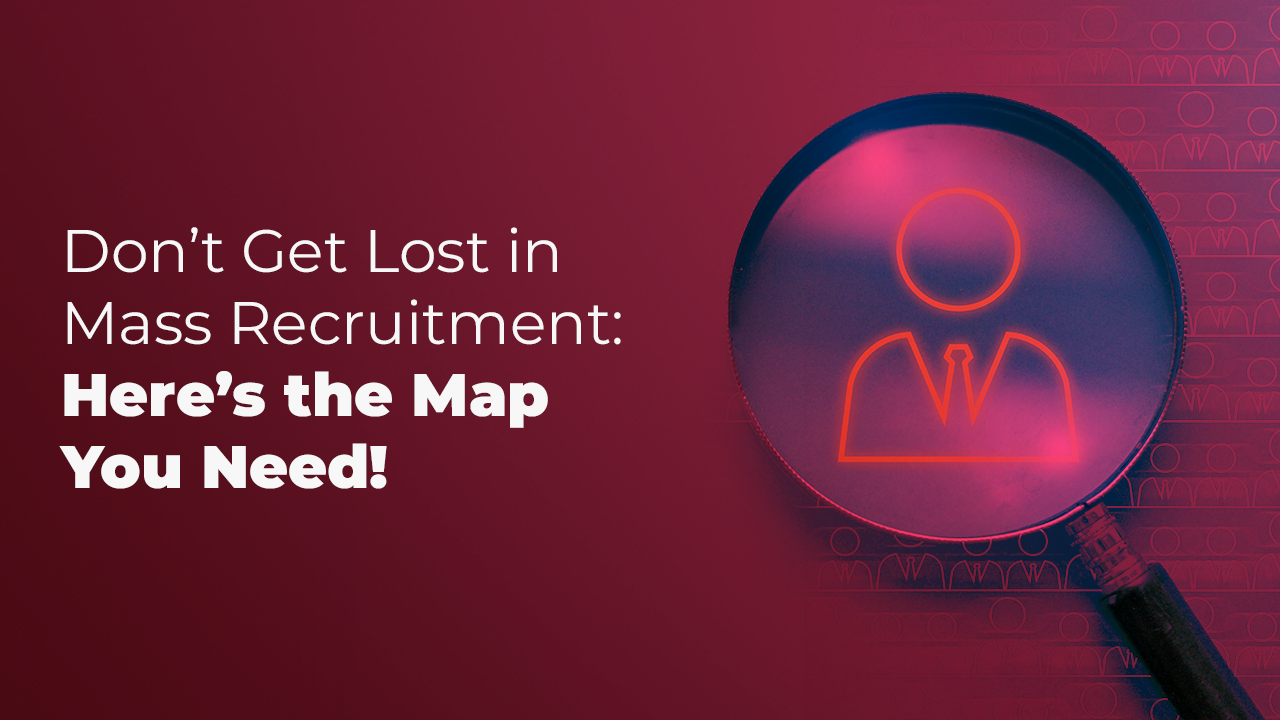Don’t Get Lost in Mass Recruitment: Here’s the Map You Need!
Mass recruitment may sound like a great opportunity at first, but when put into practice, it often feels like navigating a labyrinth. Choosing the right candidates from hundreds—even thousands—of applications, using time, resources, and the team effectively, strengthening the employer brand while also ensuring a positive candidate experience… Without a “map” in hand, getting lost along the way is almost inevitable.
In today’s hiring world, recruitment is no longer a solo journey—it’s a group expedition. So, how do we reach the right destination without losing our way during such a crowded journey?
Why Is Mass Recruitment So Challenging?
Think of mass recruitment like ordering coffee. Asking for one cup is easy: “Medium, with milk, no sugar.” But what happens when you need to order coffee for 200 people at once? One wants almond milk, another extra foam, and someone else needs it decaf. Suddenly, things become overwhelming.
That’s exactly what mass recruitment feels like. Every candidate has a unique background, expectations, and potential. To evaluate them effectively, you need to act not just quickly—but strategically.
Without a Map, Getting Lost Is Inevitable
The biggest risk in mass recruitment is losing control of the process. Getting buried under CVs, repeating the same interview questions, failing to clarify position requirements… This doesn’t just exhaust the hiring team—it can also damage the company’s employer brand.
The first rule of the map is simple: draw a clear route from the very beginning.
- Which positions are needed,
- What competencies are required,
- In what timeframe,
- With which resources.
If these aren’t defined upfront, the journey often ends halfway.
The Compass of the Map: Data
In modern recruitment, our compass is data. How many applications did we receive? From which platforms do the most qualified candidates come? At which stage do candidates struggle the most? What is our offer acceptance rate?
Answering these questions turns mass recruitment from a guessing game into a well-planned trip. A data-driven approach not only helps identify the right candidates but also improves the process continuously. After all, every mass hiring round is an experience that guides the next.
Never Forget the Candidate Experience
One of the most common mistakes in mass recruitment is thinking, “It’s a crowd anyway”—and pushing candidate experience aside. But every applicant wants to see themselves in the mirror of the company.
Even a simple notification email can transform how a candidate perceives the organization:
“We’ve received your application and will get back to you shortly.”
Yes, that email may be sent to thousands with a single click—but for each candidate, it carries personal value.
This part of the map reminds us: seeing the individual within the crowd builds long-term brand strength.
Leveraging Technology
In mass recruitment, technology is one of the most valuable allies that supports human effort. Applicant tracking systems, automated pre-screening tools, AI-assisted interview solutions… These save recruiters time and allow them to focus on more strategic tasks.
But here’s the critical point: technology can never fully replace the human touch. Algorithms can filter CVs, but motivation, passion, and cultural fit still require human judgment.
Communication: The Key to Staying on Track
Mass recruitment is always a team effort. HR, operations, managers, and sometimes external consultants—all must be reading the same map.
When communication breaks down, that’s where the biggest losses occur:
- Not knowing where a candidate stands in the process,
- Different team members asking the same questions,
- Constantly shifting priorities.
This not only drains the team but also undermines the credibility of the process. Which is why one golden rule must be on the map: coordination prevents getting lost.
Final Destination: The Right People, A Stronger Future
Companies that use the map wisely during mass recruitment don’t just fill vacant positions. They invest in the future, building long-term success with the right people.
The truth is, even the most detailed map is useless without a skilled guide to interpret it. Mass recruitment isn’t a sprint—it’s more like a team hike. The steps must be aligned, the route clear, and the guide reliable.
For those who don’t want to get lost, the most valuable tool is having the right map in hand from the very beginning. And that map? One that is data-driven, candidate-focused, technology-supported, and strengthened by communication.
In short: To avoid getting lost in mass recruitment, draw your map carefully, set your compass to data, and follow the journey with trusted guides.Mass recruitment may sound like a great opportunity at first, but when put into practice, it often feels like navigating a labyrinth. Choosing the right candidates from hundreds—even thousands—of applications, using time, resources, and the team effectively, strengthening the employer brand while also ensuring a positive candidate experience… Without a “map” in hand, getting lost along the way is almost inevitable.
In today’s hiring world, recruitment is no longer a solo journey—it’s a group expedition. So, how do we reach the right destination without losing our way during such a crowded journey?
Why Is Mass Recruitment So Challenging?
Think of mass recruitment like ordering coffee. Asking for one cup is easy: “Medium, with milk, no sugar.” But what happens when you need to order coffee for 200 people at once? One wants almond milk, another extra foam, and someone else needs it decaf. Suddenly, things become overwhelming.
That’s exactly what mass recruitment feels like. Every candidate has a unique background, expectations, and potential. To evaluate them effectively, you need to act not just quickly—but strategically.
Without a Map, Getting Lost Is Inevitable
The biggest risk in mass recruitment is losing control of the process. Getting buried under CVs, repeating the same interview questions, failing to clarify position requirements… This doesn’t just exhaust the hiring team—it can also damage the company’s employer brand.
The first rule of the map is simple: draw a clear route from the very beginning.
- Which positions are needed,
- What competencies are required,
- In what timeframe,
- With which resources.
If these aren’t defined upfront, the journey often ends halfway.
The Compass of the Map: Data
In modern recruitment, our compass is data. How many applications did we receive? From which platforms do the most qualified candidates come? At which stage do candidates struggle the most? What is our offer acceptance rate?
Answering these questions turns mass recruitment from a guessing game into a well-planned trip. A data-driven approach not only helps identify the right candidates but also improves the process continuously. After all, every mass hiring round is an experience that guides the next.
Never Forget the Candidate Experience
One of the most common mistakes in mass recruitment is thinking, “It’s a crowd anyway”—and pushing candidate experience aside. But every applicant wants to see themselves in the mirror of the company.
Even a simple notification email can transform how a candidate perceives the organization:
“We’ve received your application and will get back to you shortly.”
Yes, that email may be sent to thousands with a single click—but for each candidate, it carries personal value.
This part of the map reminds us: seeing the individual within the crowd builds long-term brand strength.
Leveraging Technology
In mass recruitment, technology is one of the most valuable allies that supports human effort. Applicant tracking systems, automated pre-screening tools, AI-assisted interview solutions… These save recruiters time and allow them to focus on more strategic tasks.
But here’s the critical point: technology can never fully replace the human touch. Algorithms can filter CVs, but motivation, passion, and cultural fit still require human judgment.
Communication: The Key to Staying on Track
Mass recruitment is always a team effort. HR, operations, managers, and sometimes external consultants—all must be reading the same map.
When communication breaks down, that’s where the biggest losses occur:
- Not knowing where a candidate stands in the process,
- Different team members asking the same questions,
- Constantly shifting priorities.
This not only drains the team but also undermines the credibility of the process. Which is why one golden rule must be on the map: coordination prevents getting lost.
Final Destination: The Right People, A Stronger Future
Companies that use the map wisely during mass recruitment don’t just fill vacant positions. They invest in the future, building long-term success with the right people.
The truth is, even the most detailed map is useless without a skilled guide to interpret it. Mass recruitment isn’t a sprint—it’s more like a team hike. The steps must be aligned, the route clear, and the guide reliable.
For those who don’t want to get lost, the most valuable tool is having the right map in hand from the very beginning. And that map? One that is data-driven, candidate-focused, technology-supported, and strengthened by communication.
In short: To avoid getting lost in mass recruitment, draw your map carefully, set your compass to data, and follow the journey with trusted guides.

